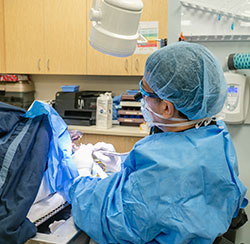As pet owners, we never want to imagine our furry friends needing surgery. However, there may come a time when your pet requires a surgical procedure to improve their health and quality of life. Our Boca Raton veterinary team at Calusa Veterinary Center is highly trained and experienced in pet surgery and anesthesia. We will take every precaution to ensure your pet's safety and comfort during surgery.
Our Surgery Suite

At Calusa Veterinary Center, we have a surgery suite that few other practices in the country can match. In addition to our state-of-the-art surgery suite, complete with advanced monitoring equipment and other modern surgical equipment, our AAHA accreditation means that we have surgery suite sterility measures in place to greatly minimize the risk of infection. Furthermore, our veterinary team has decades of training to quickly and confidently address any complications that might arise during a procedure. At Calusa Veterinary Center, we strive to ensure that your pet is provided the very best care before, during, and after these complicated procedures.
Surgeries Offered
At our hospital, we offer a wide variety of surgeries that can help your pet. We have a highly skilled team of surgeons work who are experienced in performing all types of procedures, from simple ones like mass removals to more complex surgeries like gastrointestinal tract surgery.
- General Surgery
- Advanced Surgery
- Soft Tissue Surgery
- Orthopedic Surgery
- Laser Surgery
- Spay and Neuter
- C-Section
- Amputation
- Cherry Eye Repairs
- Cystotomy Procedure
- Foreign Body Removal
- Mass/Tumor Removal
- Oncology Surgery
- Endoscopy
- Exploratory Surgery
- Biopsies
- ACL Reconstruction
- TPLO Surgery
- Gastropexy Surgery
- Splenectomy Surgery
- Gastrointestinal Procedures (e.g. tract surgery)
- Bladder Surgery
- Respiratory Surgery
- Cardiac Surgery
Advanced Surgery
For those pets requiring challenging, advanced procedures, Calusa has close working relationships with some of Florida’s top board-certified veterinary surgeons. These relationships allow pet owners to have premier surgeons perform procedures on their pets at our facility without unnecessary and potentially dangerous transfers between hospitals. The benefit of these arrangements is that your pet can have surgery performed by some of the most experienced veterinarians in the country and then recuperate under the watchful care of our exceptional nursing and team.
The Importance Of Veterinary Surgery
Veterinary surgery is a crucial aspect of pet healthcare. It can be used to diagnose and treat a variety of conditions, from broken bones to cancer. Surgery can also be used for routine procedures such as spaying and neutering. In some cases, surgery may be the only option to save your pet's life.
Preparing Your Pet For Surgery
Before your pet undergoes surgery, there are a few steps you can take to ensure they are prepared and comfortable. First, make sure to follow any pre-surgery instructions given by your us, such as withholding food and water before the procedure. This is important to prevent any complications during surgery. You may also need to temporarily stop giving any medications or supplements before the surgery. Please make sure we are aware of all medications/supplements your pet is taking so we can direct you accordingly.
Post-Surgery Care
After your pet's surgery, it is important to provide proper post-surgery care to ensure a smooth recovery. We will give you specific instructions for your pet's care, but some general tips include keeping your pet calm and confined to a quiet area, monitoring their incision site for any signs of infection, and administering any prescribed medications. It is also important to limit your pet's activity and prevent them from licking or chewing at their incision site.
Spay & Neuter Procedure
What Is Spaying & Neutering?
Spaying and neutering are surgical procedures that involve removing the reproductive organs of an animal. Spaying is the removal of a female animal's ovaries and uterus, while neutering is the removal of a male animal's testicles.
These procedures are performed by a veterinarian and are considered routine surgeries. They are often recommended for pets that are not intended for breeding.
The Procedure
The spay and neuter procedure is performed under general anesthesia, meaning your pet will be asleep and not feel any pain during the surgery. Our veterinarian will make a small incision in the abdomen for female animals or the scrotum for male animals to remove the reproductive organs.
The surgery typically takes less than an hour, and your pet will be able to go home the same day. We will provide you with post-operative care instructions to ensure a smooth recovery for your pet.
The Benefits of Spaying and Neutering
- Improved Animal Wellness: One of the main benefits of spaying and neutering is improved animal wellness. By removing the reproductive organs, you eliminate the risk of certain health issues, such as uterine infections, testicular cancer, and prostate problems. Spaying and neutering can also reduce the risk of certain types of cancer, such as mammary gland tumors in female animals and testicular cancer in male animals. These procedures can also help prevent unwanted litters, which can contribute to the overpopulation of animals in shelters.
- Behavioral Benefits: Spaying and neutering can also have behavioral benefits for your pet. Male animals that are neutered are less likely to exhibit aggressive or territorial behaviors, such as marking their territory or fighting with other animals. Female animals that are spayed will not experience heat cycles, which can be stressful for both the animal and the owner. This can also prevent unwanted behaviors, such as yowling or trying to escape to find a mate.
The Ideal Age To Spay & Neuter
The ideal age to spay or neuter a dog can vary depending on their breed and size. Smaller breeds can be spayed or neutered as early as 6 months, while larger breeds may need to wait until they are 1-2 years old.
- Cats: For cats, the ideal age to spay or neuter is between 4 and 6 months. This is before they reach sexual maturity and can start reproducing. However, we may recommend waiting until the cat is 6 to 8 months old, depending on their size and overall health.
- Dogs: The ideal age to spay or neuter a dog can vary depending on their breed and size. Smaller breeds can be spayed or neutered as early as 6 months, while larger breeds may need to wait until they are 1 year old. It is important to consult with us to determine the best age for your specific dog.
ACL Reconstruction
What Is Veterinary ACL Reconstruction?
The ACL is a ligament that connects the femur (thigh bone) to the tibia (shin bone) and helps stabilize the knee joint. It is responsible for preventing the tibia from sliding too far forward in relation to the femur.
In dogs, the ACL is one of the most injured ligaments, often due to sudden stops, twists, or turns while running or playing. This can result in a partial or complete tear of the ligament, causing pain, lameness, and instability in the knee joint.
The Procedure
During an ACL reconstruction, the torn ACL is replaced with a graft, typically taken from the dog’s own tissue or a donor. The graft is then secured in place with screws or other fixation devices.
The surgery is typically performed under general anesthesia and can take anywhere from 1-3 hours, depending on the size of the dog and the severity of the injury.
Why Is Veterinary ACL Reconstruction Done?
The primary goal of ACL reconstruction is to restore stability to the knee joint and alleviate pain and lameness in the affected leg. Without surgery, the torn ACL can lead to chronic pain, arthritis, and further damage to the knee joint.
In addition, ACL reconstruction can help prevent future injuries and improve the overall quality of life for your pet.
What To Expect During And After the Surgery
- Pre-Surgery: Before the surgery, we will perform a thorough physical examination and may also recommend X-rays or other imaging tests to assess the extent of the injury and plan for the surgery. Your pet will also need to fast before the surgery, and we may prescribe medications to help manage pain and inflammation.
- During The Surgery: During the surgery, your pet will be under general anesthesia and closely monitored by our veterinary surgery team. The surgeon will make an incision in the knee to access the torn ACL and remove any damaged tissue. The graft will then be prepared and secured in place with screws or other fixation devices. The incision will be closed with sutures or staples, and your pet will be moved to a recovery area to wake up from the anesthesia.
- Post-Surgery: After the surgery, your pet will need to stay in the hospital for some time for observation and pain management. We may also prescribe antibiotics to prevent infection. Once your pet is ready to go home, we will provide you with detailed instructions for post-surgery care, including how to manage pain, keep the incision clean, and restrict your pet’s activity.
- Recovery Time And Process: The recovery time for veterinary ACL reconstruction can vary depending on the size of your pet, the severity of the injury, and the type of graft used. In general, it can take anywhere from 4-6 months for your pet to fully recover from the surgery. During the first few weeks, your pet will need to rest and restrict their activity to allow the incision to heal and the graft to integrate with the surrounding tissue. We may also recommend physical therapy or rehabilitation exercises to help your pet regain strength and mobility in the affected leg. As your pet’s recovery progresses, we will gradually increase their activity level and we will recommend follow-up appointments to monitor their progress.
